The 11th of June is a state holiday in Hawaii known as King Kamehameha Day, which honors the Islands’ most renowned historical ruler.
According to Walter Murray Gibson, the prime minister of the Kingdom of Hawaii appointed by King Kalakaua who pushed for the famous King Kamehameha monument in Honolulu, King Kamehameha, also known as Kamehameha the Great, united the Hawaiian Islands in 1810, and set the nation on a path of a “free and enlightened government” that “compared favorably with parliamentary proceedings” of comparable civilizations and governments.
On this day, giant flower lei are draped over this statue, dubbed “The Conqueror,” as well as the four other Kamehameha sculptures located on Oahu, Hawaii Island, Maui, and in Washington, D.C., with ceremonial parades and cultural observances taking place.
Here are five interesting facts about them:
The statue at Kamehameha’s birthplace in North Kohala on Hawaii Island is the first ever created, but it was initially intended for Honolulu.
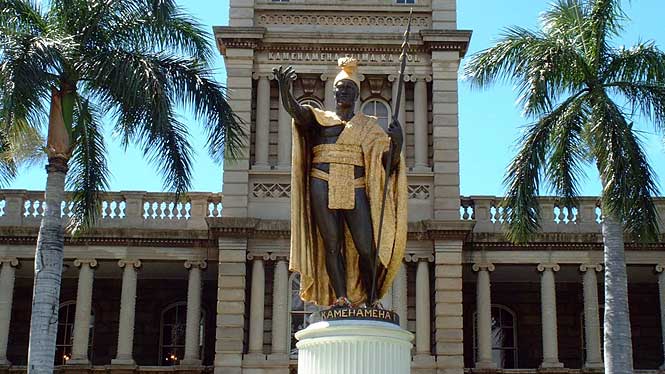
The statue in Kapaau was lost at sea in 1883, when the ship carrying it to Hawaii was wrecked near the Falkland Islands and Cape Horn. When a second casting was commissioned, the statue was eventually recovered by Falkland islanders, who left Hawaii with two statues and transported them to Waikiki aboard a British ship—the rescued/original of which currently sits in Kapaau, Kamehameha’s Kokoiki birthplace. The replica statue was erected in front of Aliiolani Hale in Honolulu, across from Iolani Palace.
According to legend, the Kamehameha statue at Grand Wailea on Maui is the most authentic image of Kamehameha the Great.
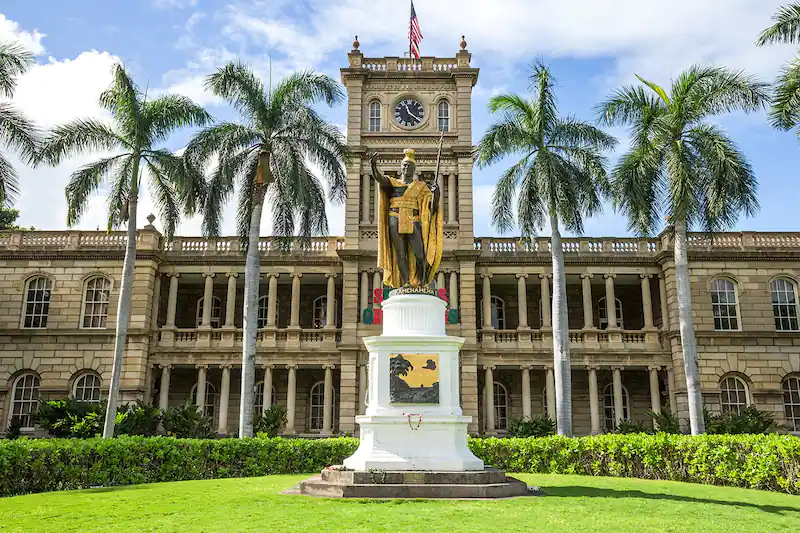
In comparison to the other Kamehameha statues created, this one from Hawaiian artist Herb Kawainui Kane in 1990 is thought to be the most lifelike, blending historical documents and Polynesian elements into the sculpture’s facial features. The current Kamehameha statue in Honolulu was commissioned by the Kingdom of Hawaii in the late nineteenth century, using an American sculptor called Thomas Ridgeway Gould, who was living and studying Italian-Roman art at the time in Florence, Italy. He was initially told to study a watercolor picture of Kamehameha by Russian expedition artist Louis Choris.
The image is notable for being part of the artist’s sole known series of portraits of Kamehameha, who sat for him in 1816, barely three years before his death. However, Gibson, the chairman of the memorial committee, was dissatisfied with the early representation and asked Gould to create a model of Kamehameha at his peak physical stature—Kamehameha as he would have appeared at 40 years old. As a result, elements of the more European influences surrounding Gould in Italy found their way into the final piece, such as the sandals worn by the statue, which appeared more Roman in size and scale than Hawaiian.
The kaai (feather sash) that wraps around Kamehameha’s waist and drapes over his left shoulder in the statue is a unique style of Hawaiian feather craftsmanship, with just three full examples known in Hawaii.
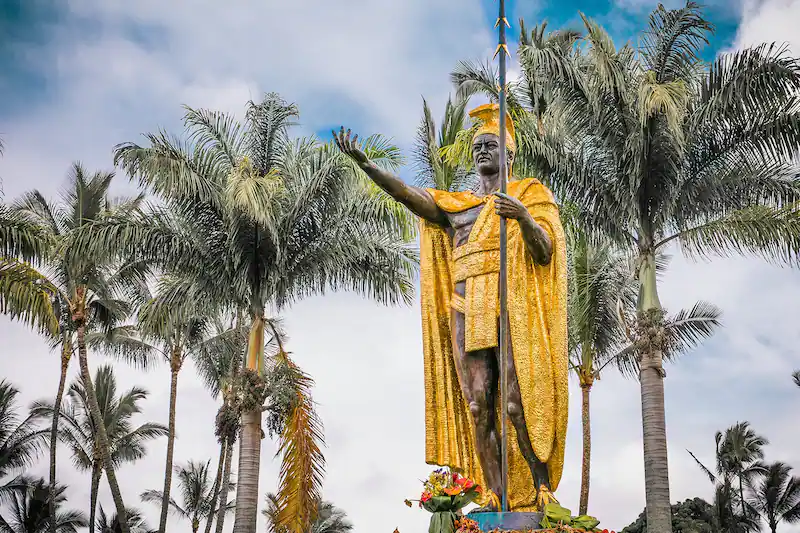
The techniques used to make the kaai are thought to predate those used to make the oldest feather cloaks discovered in Hawaiian collections. The addition of the iconographic piece commanding the center of the statue worn atop a malo (loincloth) is said to be figurative and symbolic of Kamehameha’s sacred heritage. According to the Hawaiian National Museum, the kaai incorporated into the statue was inherited by Kalakaua in 1877 and was a sash supposedly inherited by Kamehameha generations after Umi, the ruling alii of Hawaii Island who nearly united the entire island, used it to prove his chiefly status inherited by his father, high chief Liloa, whose line is traced back to the Hawaiian creation myth.
The Kamehameha statue at Hilo Bay was originally planned for the north shore of Kauai, but it was greeted with opposition.
Because Kamehameha never conquered Kauai (Kaumualii, the king of Kauai, quietly surrendered to Kamehameha to forestall certain assaults of his island), the Princeville Corporation decided to present the statue to downtown Hilo, which was a significant political hub for Kamehameha.
The U.S. Capitol Visitor Center’s Kamehameha statue is modeled after the Honolulu statue, and the lei that adorn it on Kamehameha Day are flown in from Hawaii.
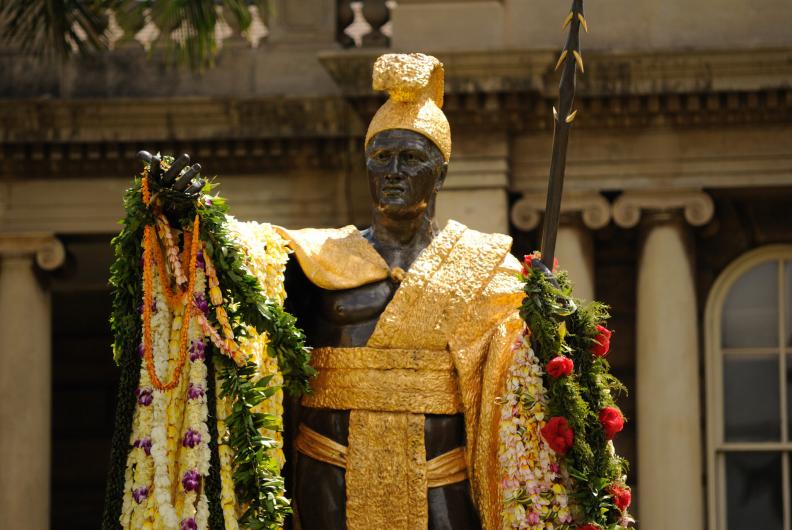
Nothing beats the pleasure of seeing the Oahu statue in its royal setting, but if you can’t make it to the Islands and are in Washington, D.C., a Kamehameha statue was donated to the National Statuary Hall collection in 1969. It is currently housed at the Capitol Visitor Center’s Emancipation Hall. On June 11, Kamehameha Day, the mainland statue is wrapped with lei and flowers, and hula performances take place.
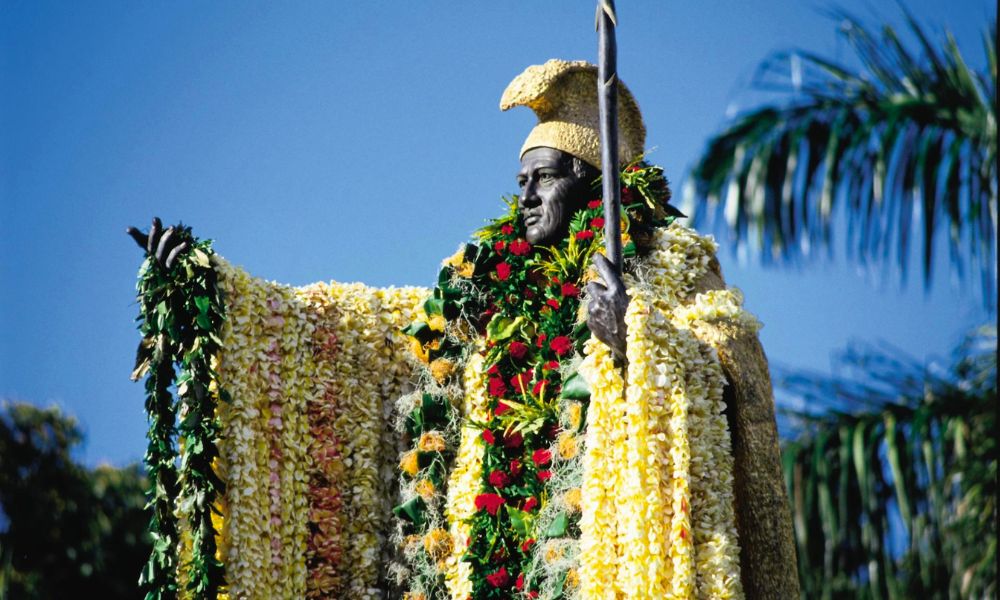
I have read so many content on the topic of the blogger lovers except this paragraph is really a nice post, keep it up.